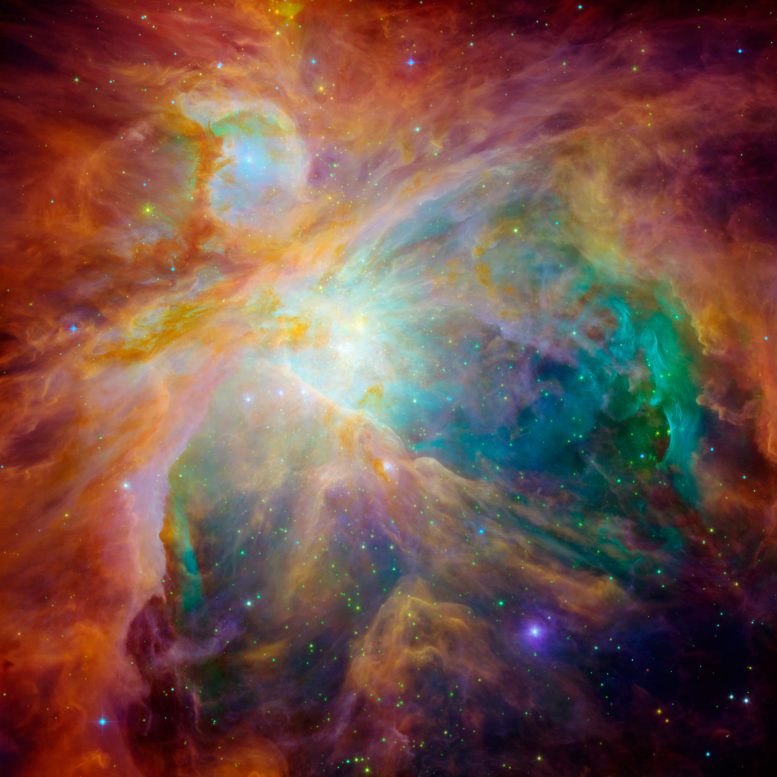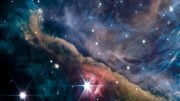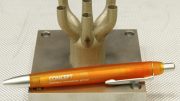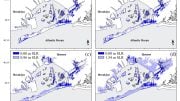
A false-color image of the Orion Nebula as seen in the combined optical and infrared with the Hubble and Spitzer Space Telescopes. A new study of a very young, massive star embedded in the region finds evidence for magnetic fields that have shaped and helped collimate the bipolar jets. Credit: NASA; Hubble and Spitzer
Astronomers used the Very Large Array radio telescopes to track the motions of the gas near radio Source I in the Orion Nebula for over nine years, adding an important link to the chain of evidence for the role of magnetic fields in influencing the properties of massive young stars.
The Orion Nebula, one of the most famous sights in the night sky, contains several clusters of hot young stars, whose intense ultraviolet radiation prompts the gas and dust to glow brightly. The nebula is about 1360 light-years away, making it the closest nursery of massive stars and one of the best-studied such regions. But despite its fame, brightness, and proximity, astronomers still do not understand it very well. It contains dramatic outflows of material, for example, that may be driven by a single star or perhaps by a cluster of stars — astronomers are not sure. The reason for this ignorance is in part because the nebula is so crowded with stars, and in part because its dust obscures many regions from optical view.
The brightest object in the nebula shines with as much light as 100,000 suns. In the past decade astronomers found that this source was itself comprised of several smaller ones, including an intense radio source called “Source I.” It is enigmatic, to put it mildly. Its motions suggest that it may have been ejected from another system just a few hundred years ago; other evidence suggests it is surrounded by a circumstellar disk of material containing natural masers (radio wavelength analogs of lasers). Such masers typically signal dense material around young stars.
CfA astronomer Lincoln Greenhill and four of his colleagues have been tracking the motions of the gas near Source I for over nine years using the Very Large Array radio telescopes. The facility is capable of resolving distances at Orion of only about twenty astronomical units (AU) – smaller than our solar system (the average distance of Uranus from the Sun is 19 AU). The goal of their research was to unravel the relative roles of the three principal processes driving massive star formation: gravity, radiation pressure, and magnetism. The effects of these processes are somewhat mysterious because it is so difficult to study the densely packed regions of activity near the surface of the star where stellar winds are launched and collimated (not to mention that the region is heavily obscured by dust).
The astronomers report finding a dynamically active, bipolar flow in the source, with strong shocks, motions of over 45,000 miles (72,000 kilometers) per hour, a mass loss rate equivalent to about one Earth-mass per year, and (perhaps most significantly) evidence for the influence of magnetic fields in the collimation and rotation of the material over a scale between about 10-1000 AU. The results add an important link to the chain of evidence for the role of magnetic fields in influencing the properties of massive young stars.
Reference: “Dynamical Evidence for a Magnetocentrifugal Wind from a 20 Msun Binary Young Stellar Object” by L. J. Greenhill, C. Goddi, C. J. Chandler, L. D. Matthews and E. M. L. Humphreys, 4 June 2013, The Astrophysical Journal Letters.
DOI: 10.1088/2041-8205/770/2/L32
arXiv:1305.4150









Be the first to comment on "Magnetic Winds From a Young Star in the Orion Nebula"